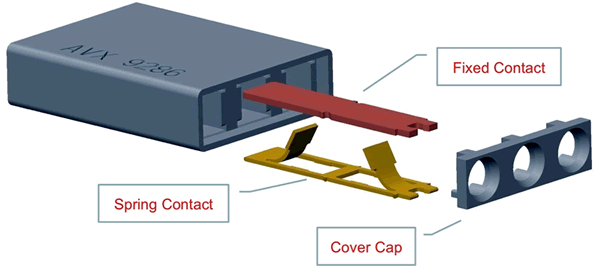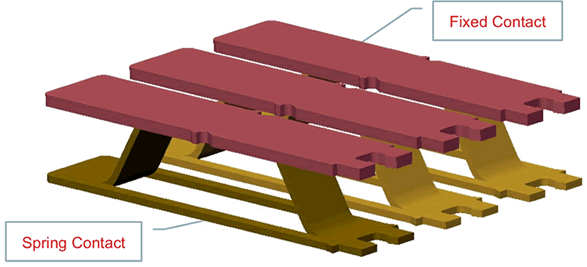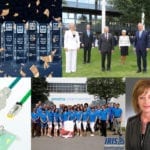How to Work with Custom Connector Suppliers
Every once in a while, rather than seek an expansion of a connector manufacturer’s already-proven product, a customer will request a standard, off-the-shelf product that’s markedly different than the supplier’s current offerings. Tom Anderson of AVX explains how his team approached one such complex challenge.
 Finding the right connector for a specific application can be challenging. Connectors are often the last components considered in the design cycle, and – despite the fact that there are more than 1,000 connector companies – engineers can never seem to find exactly what they need. As such, they often find a connector company that makes something similar to what they need and request the gap they’ve identified be filled with a new standard solution.
Finding the right connector for a specific application can be challenging. Connectors are often the last components considered in the design cycle, and – despite the fact that there are more than 1,000 connector companies – engineers can never seem to find exactly what they need. As such, they often find a connector company that makes something similar to what they need and request the gap they’ve identified be filled with a new standard solution.
Engineers typically ask for something that’s just a little different than what already exists. This process is beyond common – up to 40% of a connector manufacturer’s business – and is normally relatively quick and easy to execute, which is why we all see a seemingly endless stream of product extension announcements in trade media outlets.
Yet each of these design requests requires a connector company to answer several questions including: Does the request warrant a new product? If so, on which existing design should it be based? What volume level is needed to determine whether the new design should be a one-customer special or a broader marketable offering? What capacity or level of tooling is needed to meet the designer’s cost or volume targets?
These special requests require connector manufacturers to really delve into the details of the application requirements, market needs, and cost targets. This process is longer, more collaborative, and more labor-intensive than simply amending an existing connector solution, but ensures that the new connector fulfills all of the requirements of the customer’s design and provides engineers throughout the market with a unique new solution to their design challenges as well.
Some of these new connector developments are easier than others, but maintaining clear communication between the connector designer and product designer/customer can help turn even technologically tricky design requests into successful new developments. Early concepts and discussions will often reveal ways in which the new connector would fail to meet the requested mechanical or performance requirements. So, this critical back-and-forth allows connector design engineers to revisit and hone their concept before investing too much time or too many material resources in a solution that may not meet the mark. It also serves to solidify the most critical design requirements and ensure that they satisfy the product engineer’s expectations for the final connector. When the connector designer has a clear mental picture of what the customer is requesting, the development process works to everyone’s advantage.
One example of a successful, collaborative custom connector design is when I was challenged to develop a robust and quite small wire-to-wire connector that was both low-cost and capable of accepting a broad range of wire gauges for an industrial application. That may sound simple, but the fact that there would be flexible wires hanging from each end created a challenge with regard to the robust portion of the request.
My team and I evaluated several different contact materials and, upon closer inspection of each, struggled with either cost or performance issues. We needed to come up with a small, affordable design that would capture and securely hold a stripped wire in a range of gauges, enable quick and easy replacement or repair, carry the maximum amount of current possible, and be robust enough to withstand mechanical shocks and vibrations. Each of these specifications are attainable in and of themselves, and are common requirements for custom redesign or series extension requests but combining all seven of these specifications in a single new product design proved difficult.
Our initial thought was to design a single contact solution to minimize cost, but starting there caused us to run into all sorts of other challenges. In this case, we needed to look beyond the single contact solution we felt would be used, and work our way through our baseline competencies. After running through a number of different prototype scenarios, we were able to successfully identify the correct combination of contact material and design geometries that would allow us to satisfy all of the requirements: a unique dual-contact design capable of effectively bridging the gap between cost and performance.
In the exploded view below (Figure 1), you can see a bottom spring contact with wire engagement or capture tines made of a stainless steel base material. Stainless steel maximizes cost, strength, and flexibility, which made it seem like a perfect material selection for this request. However, stainless steel also exhibits lower conductivity than traditional connector contact materials – like brass, phosphor bronze, and beryllium copper – and would not provide adequate current-carrying capabilities.

Figure 1: Here is an exploded view of the custom connector solution that, once successfully developed, became the basis of AVX’s 9286 Series wire-to-wire poke-home connectors.
To solve this problem, we positioned simply stamped top contacts made of high-conductivity copper above the bottom spring contacts so the design could handle the current levels required (see Figure 2). In this design, the stainless steel bottom contacts not only snag the stripped wire, but also force it up against the upper, current-carrying stamped copper contacts, providing a robust electrical connection.

Figure 2: This three-position contact arrangement is designed to accommodate a positive, neutral, and ground wire in a typical wire-to-wire connector. The simply stamped top contacts made of high-conductivity copper paired with the strong, inexpensive, and flexible bottom spring contacts made of stainless steel allowed AVX to overcome design challenges to meet its customer’s requirements.
Once we arrived at this extremely unique design concept, we realized that – through collaborative communication with our customer, internal teamwork, a thorough evaluation of our core competencies, and creative innovation – we had not only successfully developed a design capable of satisfying all of the requirements of our custom design request, but could also easily modify the new connector with minimal tooling changes to create a second new product that could effectively solve different design issues we knew to be prevalent in commercial and industrial lighting, building control, security, sensor, monitoring, and factory automation applications.
The original request was for a single 1:1 wire connection, meaning that a positive wire inserted into one side would be carried through to a positive wire coming out of the other side. If, however, we didn’t separate the upper contacts in the stamping die (see Figure 3) and, instead, left them connected, we could gang-load the contact strip as a single assembly, rather than individual contacts. This would create a junction box connector capable of both easily and reliably connecting several same-function wires together and extending the cost, size, and performance benefits we painstakingly designed into our custom 1:1 solution to fill yet another gap in the market.

Figure 3: A connected version of the fixed copper contacts developed for AVX’s custom design led to an entirely different and quite useful second development.
Regardless of whether a custom connector request requires an involved innovation process like the one I just described or can be satisfied with a relatively quick and easy redesign of an existing product, collaborative communication between the connector and product designers to work out from the manufacturer’s core competencies are critical components in achieving success – whether for a single product manufacturer, the market, or industry as a whole.
Part two of this article, which will cover custom connectors for automotive applications, will appear in our April 4 issue.
Author Tom Anderson, connector product manager at AVX, has been in the connector industry for more than 30 years and has held a variety of product marketing positions. For the last 10 years, he has focused on developing new connector technologies for the automotive, industrial, and solid-state lighting markets. He can be reached at [email protected].
[hr]






